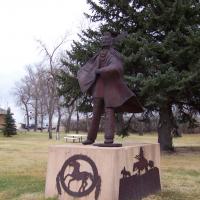History of Laurel
The City of Laurel began in 1806 when Captain William Clark of the famous Lewis and Clark expedition camped at the mouth of the Clarks Fork River where it meets the Yellowstone River. This site eventually became the town of Carlton, and later changed to the name Laurel because of an abundant local shrub found in the hometown of a railroad official from North Carolina. As time went on, the location of Laurel moved north and west, away from the Yellowstone River to its present location.
Laurel has approximately 6,300 people living within the City, with another 5,000 in the surrounding area. It is truly the small town atmosphere that keeps people living and working here.
We have three grade schools, a middle school, high school and several private pre-schools. Our public high school graduates an average of 140 students each spring and is the home of the Laurel Locomotives.
Our residents enjoy a modern bowling alley, skating rink, and a Fitness Center complete with a swimming pool, weight room, hot tub, exercise equipment and aerobic classes. The Laurel Public Library is located at 720 West 3rd Street and offers free internet/wi-fi access to visitors.
Outdoor recreation includes Riverside Park, Buffalo Mirage Fishing Access, Laurel Golf Club, and Cooney Dam.
Laurel is the site of the District 6-C boys and girls basketball tournament and the Fourth of July American Legion International Baseball Tournament.
Major employers in Laurel include Montana Rail Link and the Cenex Harvest States Refinery. Laurel straddles both sides of an intricate pattern of railroad tracks. The largest and busiest rail yard in Montana, it extends for 2 1/2 miles on a wedge-shaped piece of land between East Main Street and Shannon Road. Montana Rail Link has owned the yard since 1987. Burlington Northern Railroad operated it from 1970-1987, and Northern Pacific ran it prior to that, with the first recorded train stopping in Laurel in 1882. The “Laurel Leaf” refinery began operating in 1930. In 1943, the refinery was purchased by Farmers Union Central Exchange. In 1972, the company adopted the new name of Cenex Harvest States Refinery.
Laurel hosts the largest free fireworks display in Montana, which is put on by our Volunteer Fire Department. Each year the event attracts approximately 5-10,000 people from all over the state and Wyoming.
Laurel has five motels and one Bed and Breakfast. There are ten restaurants, with four of them open to full banquet facilities.
Laurel truly is the “Hub of Montana.” From here, all roads lead to the exciting historical and recreational attractions of Montana and Wyoming. From Laurel, you can select one of four outstanding entrances into Yellowstone Park (Cody, Red Lodge/Beartooth Highway, Gardiner, or West Yellowstone). Two major highways south will take you to Wyoming.
Head east 13 miles to Montana’s largest city, Billings, and 40 miles east to the most prominent Lewis and Clark landmark, Pompeys Pillar. Custer Battlefield, site of the most famous Indian battle, is 77 miles east of Laurel.
A little to the south, you’ll find the majestic Big Horn Canyon which holds Yellowtail Reservoir, unique for its sheer beauty and an adventure for boaters. Below that is the river some call the finest trout stream in the world – the Bighorn!
Approximately 295 miles northeast of Laurel you will find the nation’s largest earth filled dam at Fort Peck, backing up an enormous reservoir on the Missouri River with some of the best warm water fishing in the west.
West of Laurel, the renowned Yellowstone River offers some of the finest trout fishing in the world. Drive north to the fabulous beauty of Glacier Park near the Canadian border.
Our Chamber of Commerce Log Cabin Visitor Center is located in Firemen’s Park on East Main Street. You will find brochures, maps, and information pieces available about Yellowstone Park, Montana and Wyoming tourist attractions, Custer Country Tourism Region and other Montana tourism regions.
There is so much to see and do in this great state of ours and Laurel is right in the middle of it. So, let us invite you to stay awhile. Enjoy our friendly western hospitality while you make your travel plans. You’ll be glad you did.



